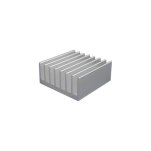Hi everyone!
I am a student at UC Davis, by no means experienced in machining (or anything really). I am attempting to make a series of slots in 6061, .030" deep, .008" wide and 2" long. The distance between each parallel slot is .010". I have had some limited success using a 1” x .008” 98 tooth HSS slitting saw on a Sierra American precision arbor, but my issue is that progress is incredibly slow.
The best combination I have stumbled on is conventionally cutting 3 passes @ .010" DOC each, 800 RPM and feed of 3 IPM. I should mention that I am currently using a Bridgeport mill, but eventually I will have access to a TM-0P. I have tried increasing RPM as well as feed, but whenever I do the "ridge" between the slots tends to curl towards the previous slot. For the part I'm making it's imperative that these ridges are straight. Due to my inexperience, I am not sure how much the information online which pertains to SFM, IPM and IPT applies to my situation. I am hoping someone with more experience can help a novice out!
As far as coolant goes, I am using a mister as well as additional compressed air to try to push chips out of the cut.
Does anyone have any tips on making this feature faster? I am mainly looking for advice on DOC and feeds/speeds, but any advice at all is very welcome.
Nick
I am a student at UC Davis, by no means experienced in machining (or anything really). I am attempting to make a series of slots in 6061, .030" deep, .008" wide and 2" long. The distance between each parallel slot is .010". I have had some limited success using a 1” x .008” 98 tooth HSS slitting saw on a Sierra American precision arbor, but my issue is that progress is incredibly slow.
The best combination I have stumbled on is conventionally cutting 3 passes @ .010" DOC each, 800 RPM and feed of 3 IPM. I should mention that I am currently using a Bridgeport mill, but eventually I will have access to a TM-0P. I have tried increasing RPM as well as feed, but whenever I do the "ridge" between the slots tends to curl towards the previous slot. For the part I'm making it's imperative that these ridges are straight. Due to my inexperience, I am not sure how much the information online which pertains to SFM, IPM and IPT applies to my situation. I am hoping someone with more experience can help a novice out!
As far as coolant goes, I am using a mister as well as additional compressed air to try to push chips out of the cut.
Does anyone have any tips on making this feature faster? I am mainly looking for advice on DOC and feeds/speeds, but any advice at all is very welcome.
Nick


